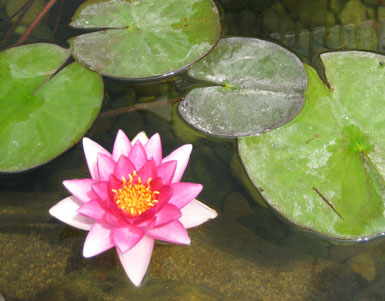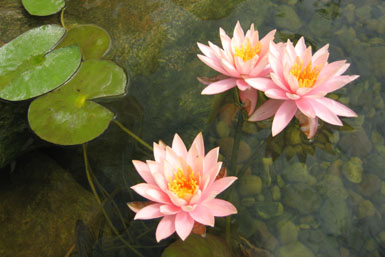

Water features require a minimum amount of care to ensure that they continue to provide the value and enjoyment you experienced when your water feature was first created. This section of the Tier One Landscape website provides some basic information to help you maintain your water feature throughout the changing seasons.
Seasonal Care
A little bit of maintenance is required to ensure the vitality and proper functioning of your water feature throughout the changing seasons. To keep things easy, Tier One Landscape provides the following seasonal care checklists for you to use as you care for your water feature:
Both checklists are in PDF format. If you are unable to open the PDF, a PDF reader is freely available for download from Adobe®.
Water Clarity
Water clarity effects not only the beauty of your water feature but the health of your aquatic fish and plants. The first step toward crystal-clear water involves the initial construction of your water feature. Tier One Landscape has unparalleled experience in creating water features with the proper structure, pumps, filters, and aeration—the foundation for exceptional water quality. However, every water feature will experience challenges with water clarity from time to time, especially during seasonal changes. If you’re facing a water clarity challenge, have no fear! A few simple rules from Tier One Landscape will start you back on the path to crystal-clear water:
- Ensure you have the proper pump size. Your pump should be large enough to turn over (or circulate) the entire volume of your feature’s water once per hour.
- Ensure your pump is in proper working condition. Make sure your the flow of water through your pump is not restricted by debris. In addition, make sure your pump is not located too high above the surface of the water. Consult the side of your pump box for further details.
- Ensure you have the right filter. Make sure your filter matches the size of your pond. Always up-size your filter so that it can filter more than the capacity of your pond. Do not exceed the maximum capacity of your filter.
- Clean your filter, but not too much. Some filters need yearly cleaning; others require more frequent cleaning. Be sure not to over-clean and wash away beneficial bacteria.
- Ensure you have proper aeration. Aeration keeps appropriate levels of oxygen in your water. Pond aerators, fountains, and waterfalls are very important for circulation.
- Ensure you have the proper number of aquatic plants. At the peak of the growing season, and if your pond receives at least 6 hours of sunlight per day, your pond should have no more than 50 to 60% of its surface covered by plants. If your pond is more than 75 degrees Fahrenheit, you might need more shade—water over 75 degrees has a tough time retaining oxygen. (More information about aquatic plants can be found in the Plant Care section of this page.)
- Ensure you have the proper number of fish. If you have more than 10 inches of fish per every 100 gallons of water, it might be time to find some of them a new home.
- Ensure you’re not overfeeding your fish. Your fish should eat no more than once per day, and no more than they can consume in 2 to 3 minutes. Be sure to remove any excess food.
- Ensure your pond is clear of bottom debris. Decaying debris causes ammonia levels to spike in your pond. Clean your pond when necessary, and use beneficial microbes such as those found in Aquascape’s AquaClearer product cited below.
Tier One Landscape also recommends a handful of products to keep your water clean and clear. Aquascape™ offers a variety of excellent products—all of which are 100% fish- and plant-safe—here are some of Tier One’s favorites:
- AquaClearer™ Extreme Liquid: contains beneficial bacteria and enzymes that reduce sludge, fish waste, and excess nutrients. Also contains microbes that control ammonia and nitrite levels.
- EcoBlast™: knocks out string algae.
- SAB™ Extreme: removes unwanted debris around streams, waterfalls, and ponds.
Ecological Laboratories is another excellent source for water feature products. Tier One Landscape has found the following items to be very effective (and also 100% fish- and plant-safe):
- Microbe-Lift/PL®: balances water feature ecosystems; reduces sludge build-up; keeps water clean and clear. Very effective. (Use Microbe-Life/HC for larger ponds or lakes.)
- SA (Sludge Away)™: helps remove organic sludge build-up. Use in conjunction with Microbe-Lift/PL.
As with all pond products, be sure to read all package labeling and directions before use.
Water Plant Care
Aquatic plants—such as water lilies, marginal plants (including various water grasses), and lotuses—increase the beauty of your pond, adding color, texture, and a naturalizing effect. Did you know that they’re also very hard workers? Plants are very important to your pond’s ecosystem, removing nutrients from the water that would otherwise feed unwanted algae. In addition, aquatic plants provide shade, food, and protection for the fish and other wildlife that enjoy your pond. To best care for these hardworking beauties, follow these simple steps from Tier One Landscape:
- Plant aquatic plants properly. Aquatic plants can typically be kept in the containers in which you purchase them if you plan to place them directly in your pond. Securely nestle pots and baskets into the natural pockets and corners of your pond. Be sure to place the plants in low-traffic, low-wave areas, and follow the growing instructions that come with the plant.
- Fertilize. Like any plant, aquatic plants need to be fed on a regular basis. Marginal plants and lotuses require feeding every 8 to 12 weeks, while lilies bloom best when feed every 2 to 3 weeks. Many suppliers offer slow-release fertilizer tabs or rods that make fertilizing easy—just be sure not to insert them too close to the root in order to avoid root burn.
- Perform regular maintenance. Remove yellowing or dead leaves when they appear. Not only will this keep your pond looking beautiful, but it will also prevent dead plant material from decaying in your water.
For more detailed information about aquatic plants, consult your Tier One Landscape professional or check out Aquascape’s book, The Hobbyist’s Guide to Pond Plants.
Fish Care
Tier One Landscape loves fish! (We named ours – do you?) And we know you do, too. Ornamental, freshwater goldfish, koi, and butterfly koi come in a variety of sizes and colors. While they are typically very easy to care for, we do recommend a few simple steps to ensure the health, vibrancy, and longevity of our aquatic friends:
- Keep your pond water clean and clear.
- Purchase a pond thermometer so you can track water temperature.
- Use beneficial bacteria, such as AquaScape™ AquaClearer™ Extreme or Ecological Laboratories Microbe-Lift/PL®, to ensure pond cleanliness.
- Use AquaScape™ EcoStarter™ Plus Liquid to remove the chlorine and ammonia prevalent in new ponds.
- Don’t feed your fish every day, and don’t feed them more than they can eat in 2 to 3 minutes. Remember that excess food ends up as food for algae!
- Store fish food in a cool, moisture-free environment and an air-tight container.
- Consider feeding fish in the same location, and using a regular sound—such as a stone knocked against another stone—to announce feeding time. You’d be surprised how friendly a fish can become over time!
For those of us living in northern climates, winter care for our fish is a key concern. Your fish can easily survive the winter season if your pond does not freeze to the bottom and an air hole is provided for circulation. You can purchase water heaters of any size as well as circulator pumps to ensure your fish’s safety through the colder months of the year. In addition, be sure to stop feeding your fish once your pond’s water temperature reaches a consistent 55 degrees Fahrenheit. At that temperature, pond fish enter a state of dormancy and should not be fed again until the temperature climbs back above 55 degrees. For more information about wintering fish and any other pond fish topics, consult with your Tier One Landscape professional or check out Aquascape’s book, The Hobbyist’s Guide to Pond Fish.
Tier One Landscape hopes you find this information helpful. Tier One Landscape does, however, recommend that you read all product instructions and consult with a water feature professional. Though Tier One Landscape provides this information for your use in good faith, this information is offered as-is, without warranty of any kind; please use at your own discretion. If you have any questions about these or other landscape topics, please contact Tier One Landscape.